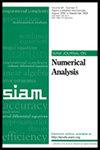Orthogonal Polynomial Approximation and Extended Dynamic Mode Decomposition in Chaos
IF 2.9
2区 数学
Q1 MATHEMATICS, APPLIED
引用次数: 0
Abstract
SIAM Journal on Numerical Analysis, Volume 63, Issue 1, Page 122-148, February 2025.Abstract. Extended dynamic mode decomposition (EDMD) is a data-driven tool for forecasting and model reduction of dynamics, which has been extensively taken up in the physical sciences. While the method is conceptually simple, in deterministic chaos it is unclear what its properties are or even what it converges to. In particular, it is not clear how EDMD’s least-squares approximation treats the classes of differentiable functions on which chaotic systems act. We develop for the first time a general, rigorous theory of EDMD on the simplest examples of chaotic maps: analytic expanding maps of the circle. To do this, we prove a new, basic approximation result in the theory of orthogonal polynomials on the unit circle (OPUC) and apply methods from transfer operator theory. We show that in the infinite-data limit, the least-squares projection error is exponentially small for trigonometric polynomial observable dictionaries. As a result, we show that forecasts and Koopman spectral data produced using EDMD in this setting converge to the physically meaningful limits, exponentially fast with respect to the size of the dictionary. This demonstrates that with only a relatively small polynomial dictionary, EDMD can be very effective, even when the sampling measure is not uniform. Furthermore, our OPUC result suggests that data-based least-squares projection may be a very effective approximation strategy more generally.
混沌中的正交多项式逼近与扩展动态模态分解
SIAM数值分析杂志,第63卷,第1期,第122-148页,2025年2月。摘要。扩展动态模态分解(EDMD)是一种数据驱动的动力学预测和模型简化工具,在物理科学中得到了广泛的应用。虽然这个方法在概念上很简单,但在确定性的混沌中,它的性质是什么甚至收敛到什么都不清楚。特别是,EDMD的最小二乘近似如何处理混沌系统作用于的可微函数类尚不清楚。在混沌映射的最简单例子——圆的解析展开映射上,我们首次提出了一个一般的、严格的EDMD理论。为此,我们证明了单位圆上正交多项式理论(OPUC)中的一个新的基本近似结果,并应用了传递算子理论中的方法。我们证明了在无限数据限制下,三角多项式可观测字典的最小二乘投影误差是指数小的。结果表明,在这种情况下,使用EDMD生成的预测和库普曼光谱数据收敛到物理上有意义的极限,相对于字典的大小而言,速度呈指数级增长。这表明,即使在采样测量不均匀的情况下,仅使用相对较小的多项式字典,EDMD也可以非常有效。此外,我们的OPUC结果表明,基于数据的最小二乘投影可能是一种非常有效的近似策略。
本文章由计算机程序翻译,如有差异,请以英文原文为准。
求助全文
约1分钟内获得全文
求助全文
来源期刊
CiteScore
4.80
自引率
6.90%
发文量
110
审稿时长
4-8 weeks
期刊介绍:
SIAM Journal on Numerical Analysis (SINUM) contains research articles on the development and analysis of numerical methods. Topics include the rigorous study of convergence of algorithms, their accuracy, their stability, and their computational complexity. Also included are results in mathematical analysis that contribute to algorithm analysis, and computational results that demonstrate algorithm behavior and applicability.

 求助内容:
求助内容: 应助结果提醒方式:
应助结果提醒方式:


